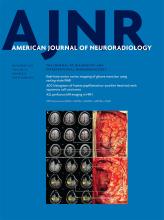Abstract
BACKGROUND AND PURPOSE: Anterior communicating artery aneurysm rupture and treatment is associated with high rates of dependency, which are more severe after clipping compared with coiling. To determine whether ischemic injury might account for these differences, we characterized cerebral infarction burden, infarction patterns, and patient outcomes after surgical or endovascular treatment of ruptured anterior communicating artery aneurysms.
MATERIALS AND METHODS: We performed a retrospective cohort study of consecutive patients with ruptured anterior communicating artery aneurysms. Patient data and neuroimaging studies were reviewed. A propensity score for outcome measures was calculated to account for the nonrandom assignment to treatment. Primary outcome was the frequency of frontal lobe and striatum ischemic injury. Secondary outcomes were patient mortality and clinical outcome at discharge and at 3 months.
RESULTS: Coiled patients were older (median, 55 versus 50 years; P = .03), presented with a worse clinical status (60% with Hunt and Hess Score >2 versus 34% in clipped patients; P = .02), had a higher modified Fisher grade (P = .01), and were more likely to present with intraventricular hemorrhage (78% versus 56%; P = .03). Ischemic frontal lobe infarction (OR, 2.9; 95% CI, 1.1–8.4; P = .03) and recurrent artery of Heubner infarction (OR, 20.9; 95% CI, 3.5–403.7; P < .001) were more common in clipped patients. Clipped patients were more likely to be functionally dependent at discharge (OR, 3.2; P = .05) compared with coiled patients. Mortality and clinical outcome at 3 months were similar between coiled and clipped patients.
CONCLUSIONS: Frontal lobe and recurrent artery of Heubner infarctions are more common after surgical clipping of ruptured anterior communicating artery aneurysms, and are associated with poorer clinical outcomes at discharge.
ABBREVIATIONS:
- AcomA
- anterior communicating artery aneurysm
- RAH
- recurrent artery of Heubner
- HHS
- Hunt and Hess Scale
- © 2017 by American Journal of Neuroradiology












